深度解密Go语言之context
Go 语言的 context 包短小精悍,非常适合新手学习。不论是它的源码还是实际使用,都值得投入时间去学习。
什么是 context
- Go 1.7 标准库引入 context,中文译作“上下文”,准确说它是 goroutine 的上下文,包含 goroutine 的运行状态、环境、现场等信息。
- context 主要用来在 goroutine 之间传递上下文信息,包括:取消信号、超时时间、截止时间、k-v 等。
- 随着 context 包的引入,标准库中很多接口因此加上了 context 参数,例如 database/sql 包。context 几乎成为了并发控制和超时控制的标准做法。
context.Context 类型的值可以协调多个 groutine 中的代码执行“取消”操作,并且可以存储键值对。最重要的是它是并发安全的。与它协作的 API 都可以由外部控制执行“取消”操作,例如:取消一个 HTTP 请求的执行。
为什么有 context
Go 常用来写后台服务,通常只需要几行代码,就可以搭建一个 http server。在 Go 的 server 里,通常每来一个请求都会启动若干个 goroutine 同时工作:有些去数据库拿数据,有些调用下游接口获取相关数据……

- 这些 goroutine 需要共享这个请求的基本数据,例如登陆的 token,处理请求的最大超时时间(如果超过此值再返回数据,请求方因为超时接收不到)等等。当请求被取消或是处理时间太长,这有可能是使用者关闭了浏览器或是已经超过了请求方规定的超时时间,请求方直接放弃了这次请求结果。这时,所有正在为这个请求工作的 goroutine 需要快速退出,因为它们的“工作成果”不再被需要了。在相关联的 goroutine 都退出后,系统就可以回收相关的资源。
- 再多说一点,Go 语言中的 server 实际上是一个“协程模型”,也就是说一个协程处理一个请求。例如在业务的高峰期,某个下游服务的响应变慢,而当前系统的请求又没有超时控制,或者超时时间设置地过大,那么等待下游服务返回数据的协程就会越来越多。而我们知道,协程是要消耗系统资源的,后果就是协程数激增,内存占用飙涨,甚至导致服务不可用。更严重的会导致雪崩效应,整个服务对外表现为不可用,这肯定是 P0 级别的事故。这时,肯定有人要背锅了。
- 其实前面描述的 P0 级别事故,通过设置“允许下游最长处理时间”就可以避免。
- 例如,给下游设置的 timeout 是 50 ms,如果超过这个值还没有接收到返回数据,就直接向客户端返回一个默认值或者错误。
- 例如,返回商品的一个默认库存数量。
context 包就是为了解决上面所说的这些问题而开发的:在 一组 goroutine 之间传递共享的值、取消信号、deadline……

用简练一些的话来说,在 Go 里,我们不能直接杀死协程,协程的关闭一般会用
channel+select方式来控制。
但是在某些场景下,例如处理一个请求衍生了很多协程,这些协程之间是相互关联的:需要共享一些全局变量、有共同的 deadline 等,而且可以同时被关闭。再用 channel+select 就会比较麻烦,这时就可以通过 context 来实现。
一句话:context 用来解决 goroutine 之间
退出通知、元数据传递的功能。
源码整体概览
context 包的代码并不长,context.go 文件总共不到 500 行,其中还有很多大段的注释,代码可能也就 200 行左右的样子,是一个非常值得研究的代码库。
先给大家看一张整体的图:
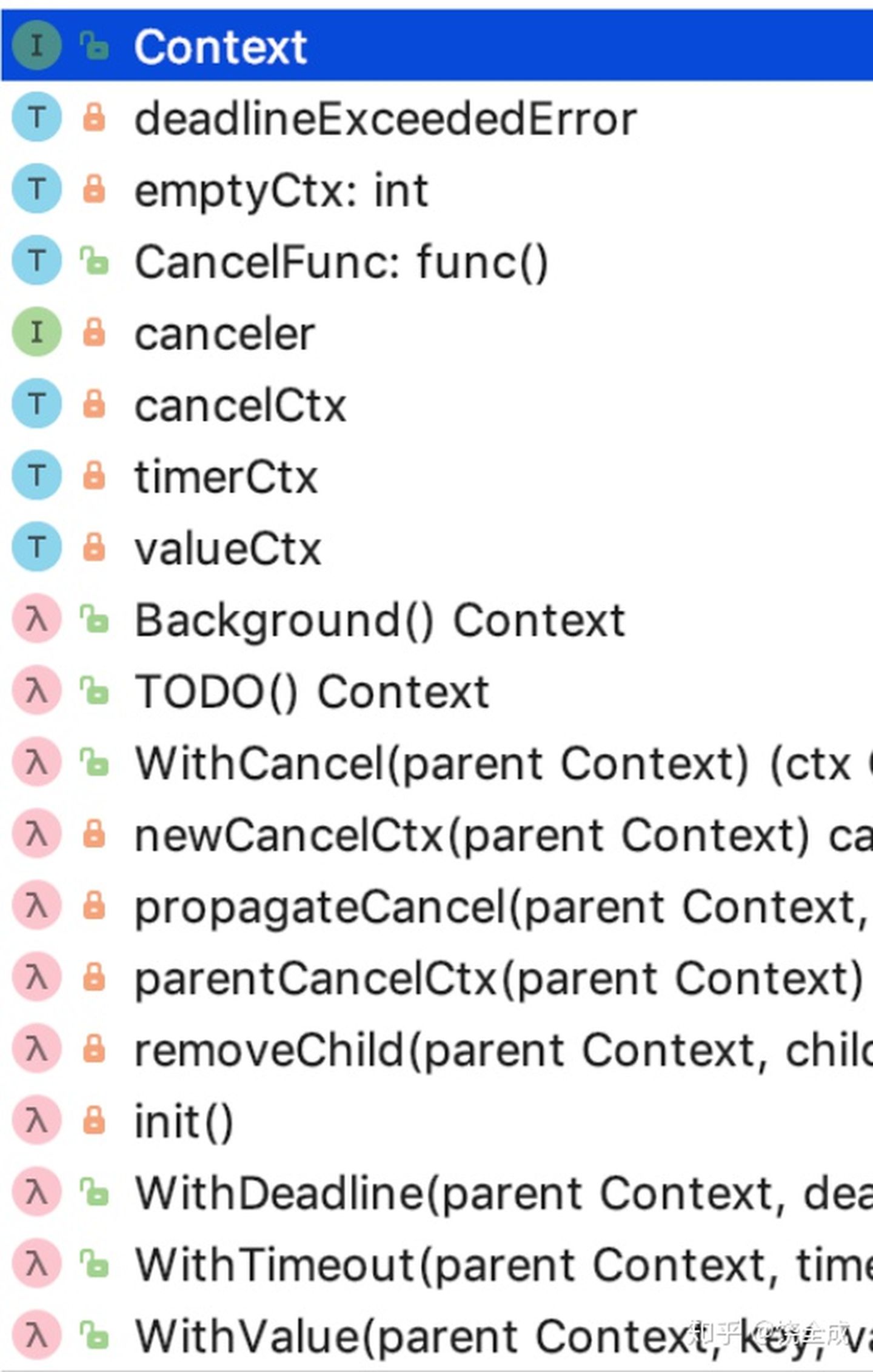
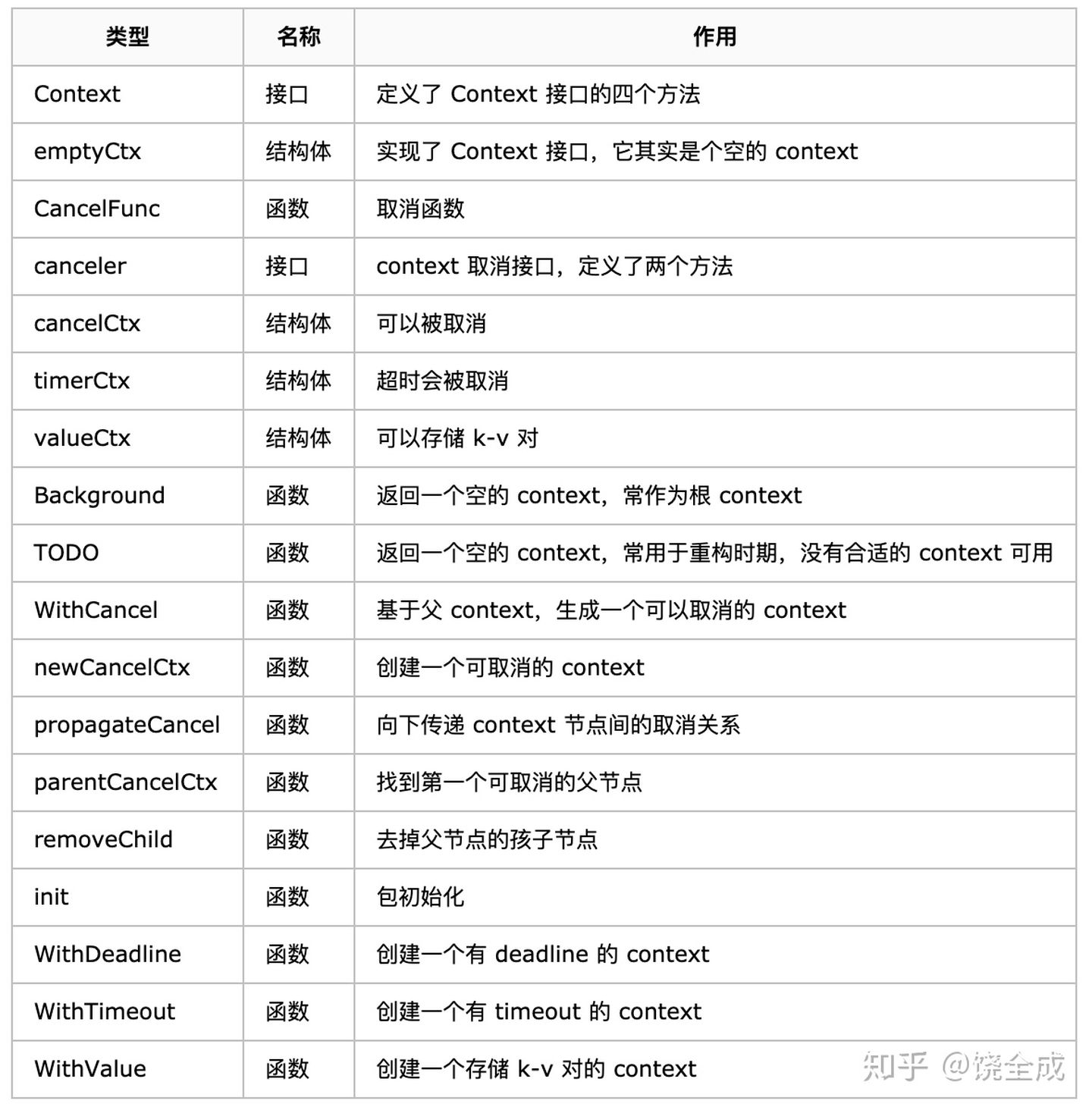
上面这张表展示了 context 的所有函数、接口、结构体,可以纵览全局,可以在读完文章后,再回头细看。
整体类图如下:
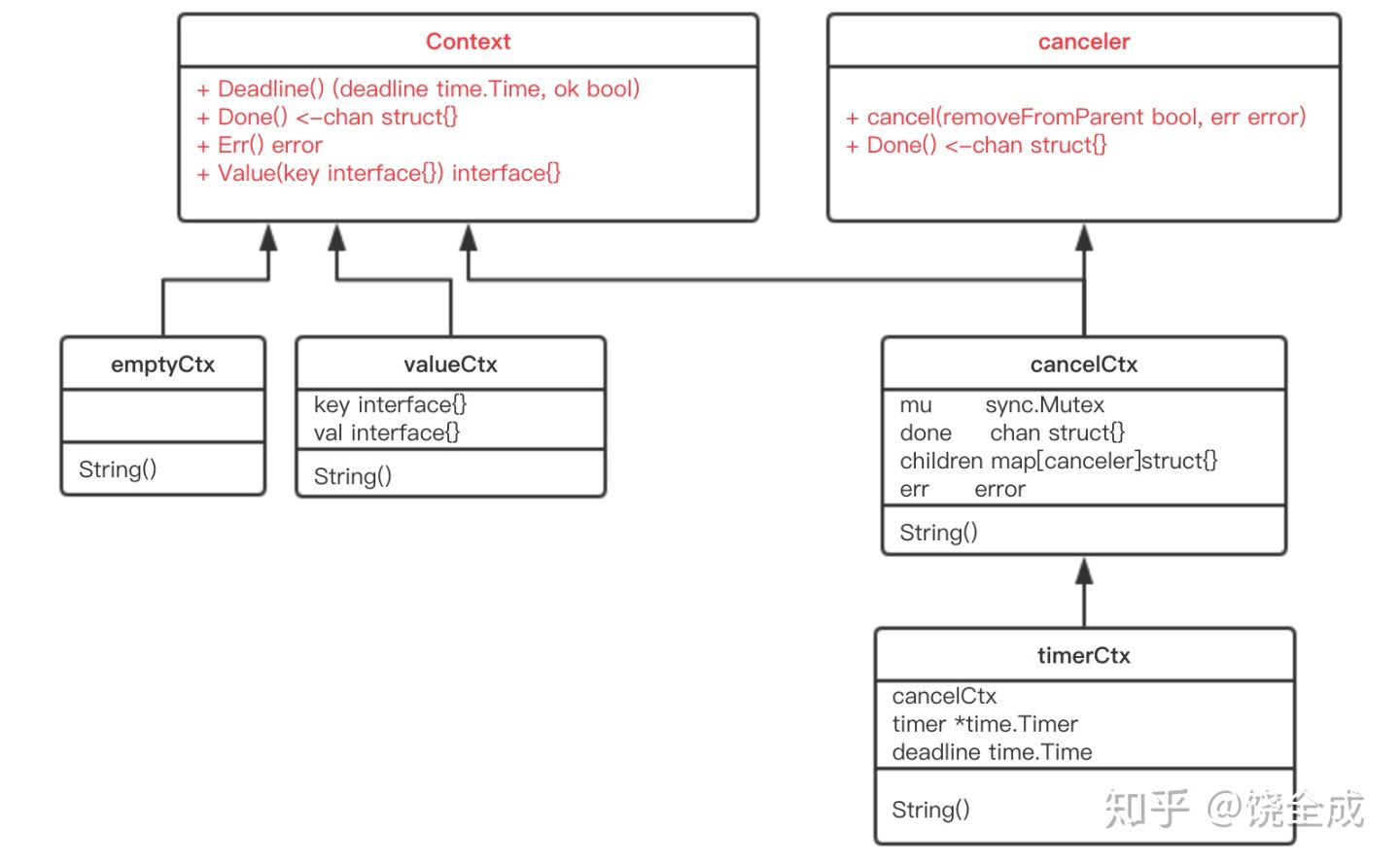
接口
Context
现在可以直接看源码:
1 | type Context interface { |
Context 是一个接口,定义了 4 个方法,它们都是幂等的。也就是说连续多次调用同一个方法,得到的结果都是相同的。
Done()返回一个 channel,可以表示 context 被取消的信号:当这个 channel 被关闭时,说明 context 被取消了注意,这是一个只读的channel。
我们又知道,读一个关闭的 channel 会读出相应类型的零值。并且源码里没有地方会向这个 channel 里面塞入值。换句话说,这是一个
receive-only的 channel。因此在子协程里读这个 channel,除非被关闭,否则读不出来任何东西。也正是利用了这一点,子协程从 channel 里读出了值(零值)后,就可以做一些收尾工作,尽快退出。
Err()返回一个错误,表示 channel 被关闭的原因。例如是被取消,还是超时。Deadline()返回 context 的截止时间,通过此时间,函数就可以决定是否进行接下来的操作,如果时间太短,就可以不往下做了,否则浪费系统资源。当然,也可以用这个 deadline 来设置一个 I/O 操作的超时时间。Value()获取之前设置的 key 对应的 value。
canceler
再来看另外一个接口:
1 | type canceler interface { |
实现了上面定义的两个方法的 Context,就表明该 Context 是可取消的。
源码中有两个类型实现了 canceler 接口:*cancelCtx 和 *timerCtx。注意是加了 * 号的,是这两个结构体的指针实现了 canceler 接口。
Context 接口设计成这个样子的原因:
- “取消”操作应该是建议性,而非强制性
caller 不应该去关心、干涉 callee 的情况,决定如何以及何时返回是 callee 的责任。caller 只需发送“取消”信息,callee 根据收到的信息来做进一步的决策,因此接口并没有定义 cancel 方法。
- “取消”操作应该可传递
“取消”某个函数时,和它相关联的其他函数也应该“取消”。因此,
Done()方法返回一个只读的 channel,所有相关函数监听此 channel。一旦 channel 关闭,通过 channel 的“广播机制”,所有监听者都能收到。
结构体
emptyCtx
源码中定义了 Context 接口后,并且给出了一个实现:
1 | type emptyCtx int |
看这段源码,非常 happy。因为每个函数都实现的异常简单,要么是直接返回,要么是返回 nil。
所以,这实际上是一个空的 context,永远不会被 cancel,没有存储值,也没有 deadline。
它被包装成:
1 | var ( |
通过下面两个导出的函数(首字母大写)对外公开:
1 | func Background() Context { |
background 通常用在 main 函数中,作为所有 context 的根节点。
todo 通常用在并不知道传递什么 context 的情形。例如,调用一个需要传递 context 参数的函数,你手头并没有其他 context 可以传递,这时就可以传递 todo。这常常发生在重构进行中,给一些函数添加了一个 Context 参数,但不知道要传什么,就用 todo “占个位子”,最终要换成其他 context。
cancelCtx
再来看一个重要的 context:
1 | type cancelCtx struct { |
这是一个可以取消的 Context,实现了 canceler 接口。它直接将接口 Context 作为它的一个匿名字段,这样,它就可以被看成一个 Context。
先来看 Done() 方法的实现:
1 | func (c *cancelCtx) Done() <-chan struct{} { |
c.done 是“懒汉式”创建,只有调用了 Done() 方法的时候才会被创建。再次说明,函数返回的是一个只读的 channel,而且没有地方向这个 channel 里面写数据。所以,直接调用读这个 channel,协程会被 block 住。一般通过搭配 select 来使用。一旦关闭,就会立即读出零值。
Err() 和 String() 方法比较简单,不多说。推荐看源码,非常简单。
接下来,我们重点关注 cancel() 方法的实现:
1 | func (c *cancelCtx) cancel(removeFromParent bool, err error) { |
总体来看,cancel() 方法的功能就是关闭 channel:c.done;递归地取消它的所有子节点;从父节点从删除自己。达到的效果是通过关闭 channel,将取消信号传递给了它的所有子节点。goroutine 接收到取消信号的方式就是 select 语句中的读 c.done 被选中。
我们再来看创建一个可取消的 Context 的方法:
1 | func WithCancel(parent Context) (ctx Context, cancel CancelFunc) { |
这是一个暴露给用户的方法,传入一个父 Context(这通常是一个 background,作为根节点),返回新建的 context,新 context 的 done channel 是新建的(前文讲过)。
当 WithCancel 函数返回的 CancelFunc 被调用或者是父节点的 done channel 被关闭(父节点的 CancelFunc 被调用),此 context(子节点) 的 done channel 也会被关闭。
注意传给 WithCancel 方法的参数,前者是 true,也就是说取消的时候,需要将自己从父节点里删除。第二个参数则是一个固定的取消错误类型:
1 | var Canceled = errors.New("context canceled") |
还注意到一点,调用子节点 cancel 方法的时候,传入的第一个参数 removeFromParent 是 false。
两个问题需要回答:1. 什么时候会传 true?2. 为什么有时传 true,有时传 false?
当 removeFromParent 为 true 时,会将当前节点的 context 从父节点 context 中删除:
1 | func removeChild(parent Context, child canceler) { |
最关键的一行:
1 | delete(p.children, child) |
什么时候会传 true 呢?答案是调用 WithCancel() 方法的时候,也就是新创建一个可取消的 context 节点时,返回的 cancelFunc 函数会传入 true。这样做的结果是:当调用返回的 cancelFunc 时,会将这个 context 从它的父节点里“除名”,因为父节点可能有很多子节点,你自己取消了,所以我要和你断绝关系,对其他人没影响。
在取消函数内部,我知道,我所有的子节点都会因为我的一:c.children = nil 而化为灰烬。我自然就没有必要再多做这一步,最后我所有的子节点都会和我断绝关系,没必要一个个做。另外,如果遍历子节点的时候,调用 child.cancel 函数传了 true,还会造成同时遍历和删除一个 map 的境地,会有问题的。
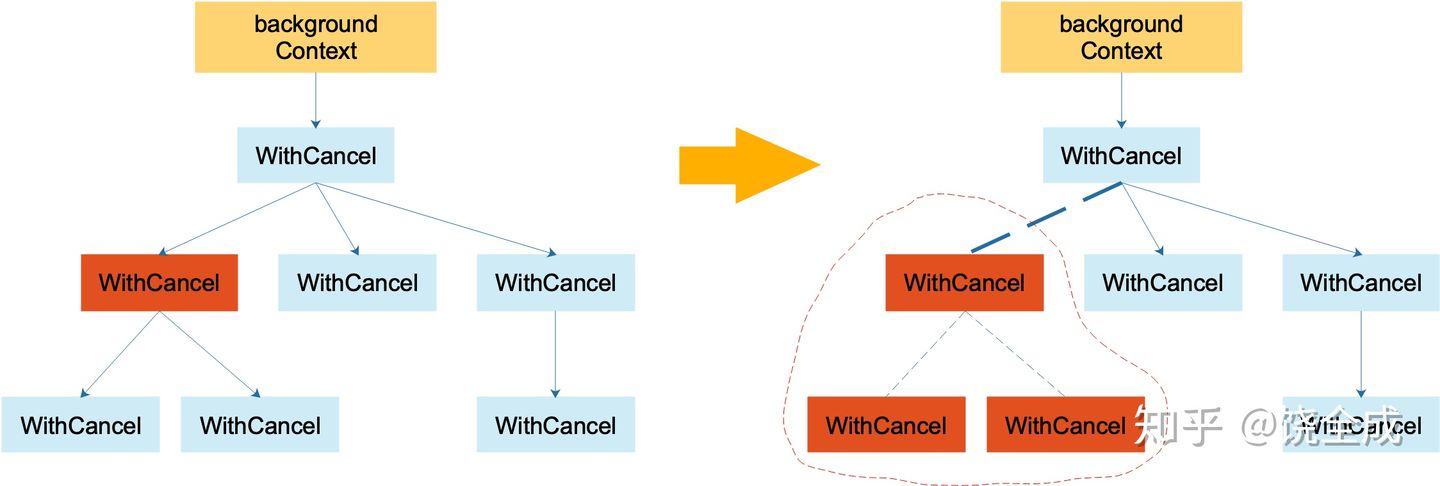
如上左图,代表一棵 context 树。当调用左图中标红 context 的 cancel 方法后,该 context 从它的父 context 中去除掉了:实线箭头变成了虚线。且虚线圈框出来的 context 都被取消了,圈内的 context 间的父子关系都荡然无存了。
重点看 propagateCancel():
1 | func propagateCancel(parent Context, child canceler) { |
这个方法的作用就是向上寻找可以“挂靠”的“可取消”的 context,并且“挂靠”上去。这样,调用上层 cancel 方法的时候,就可以层层传递,将那些挂靠的子 context 同时“取消”。
这里着重解释下为什么会有 else 描述的情况发生。else 是指当前节点 context 没有向上找到可以取消的父节点,那么就要再启动一个协程监控父节点或者子节点的取消动作。
这里就有疑问了,既然没找到可以取消的父节点,那 case <-parent.Done() 这个 case 就永远不会发生,所以可以忽略这个 case;而 case <-child.Done() 这个 case 又啥事不干。那这个 else 不就多余了吗?
其实不然。我们来看 parentCancelCtx 的代码:
1 | func parentCancelCtx(parent Context) (*cancelCtx, bool) { |
这里只会识别三种 Context 类型:cancelCtx,timerCtx,*valueCtx。若是把 Context 内嵌到一个类型里,就识别不出来了。
由于 context 包的代码并不多,所以我直接把它 copy 出来了,然后在 else 语句里加上了几条打印语句,来验证上面的说法:
1 | type MyContext struct { |
我自已在 else 里添加的打印语句我就不贴出来了,感兴趣的可以自己动手实验下。我们看下三个 context 的打印结果:
1 | context.Background.WithCancel |
果然,mctx,childCtx 和正常的 parentCtx 不一样,因为它是一个自定义的结构体类型。
else 这段代码说明,如果把 ctx 强行塞进一个结构体,并用它作为父节点,调用 WithCancel 函数构建子节点 context 的时候,Go 会新启动一个协程来监控取消信号,明显有点浪费嘛。
再来说一下,select 语句里的两个 case 其实都不能删。
1 | select { |
第一个 case 说明当父节点取消,则取消子节点。如果去掉这个 case,那么父节点取消的信号就不能传递到子节点。
第二个 case 是说如果子节点自己取消了,那就退出这个 select,父节点的取消信号就不用管了。如果去掉这个 case,那么很可能父节点一直不取消,这个 goroutine 就泄漏了。当然,如果父节点取消了,就会重复让子节点取消,不过,这也没什么影响嘛。
timerCtx
timerCtx 基于 cancelCtx,只是多了一个 time.Timer 和一个 deadline。Timer 会在 deadline 到来时,自动取消 context。
1 | type timerCtx struct { |
timerCtx 首先是一个 cancelCtx,所以它能取消。看下 cancel() 方法:
1 | func (c *timerCtx) cancel(removeFromParent bool, err error) { |
创建 timerCtx 的方法:
1 | func WithTimeout(parent Context, timeout time.Duration) (Context, CancelFunc) { |
WithTimeout 函数直接调用了 WithDeadline,传入的 deadline 是当前时间加上 timeout 的时间,也就是从现在开始再经过 timeout 时间就算超时。也就是说,WithDeadline 需要用的是绝对时间。重点来看它:
1 | func WithDeadline(parent Context, deadline time.Time) (Context, CancelFunc) { |
也就是说仍然要把子节点挂靠到父节点,一旦父节点取消了,会把取消信号向下传递到子节点,子节点随之取消。
有一个特殊情况是,如果要创建的这个子节点的 deadline 比父节点要晚,也就是说如果父节点是时间到自动取消,那么一定会取消这个子节点,导致子节点的 deadline 根本不起作用,因为子节点在 deadline 到来之前就已经被父节点取消了。
这个函数的最核心的一句是:
1 | c.timer = time.AfterFunc(d, func() { |
c.timer 会在 d 时间间隔后,自动调用 cancel 函数,并且传入的错误就是 DeadlineExceeded:
1 | var DeadlineExceeded error = deadlineExceededError{} |
也就是超时错误。
valueCtx
1 | type valueCtx struct { |
它实现了两个方法:
1 | func (c *valueCtx) String() string { |
由于它直接将 Context 作为匿名字段,因此仅管它只实现了 2 个方法,其他方法继承自父 context。但它仍然是一个 Context,这是 Go 语言的一个特点。
创建 valueCtx 的函数:
1 | func WithValue(parent Context, key, val interface{}) Context { |
对 key 的要求是可比较,因为之后需要通过 key 取出 context 中的值,可比较是必须的。
通过层层传递 context,最终形成这样一棵树:
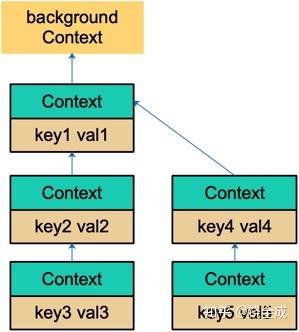
和链表有点像,只是它的方向相反:Context 指向它的父节点,链表则指向下一个节点。通过 WithValue 函数,可以创建层层的 valueCtx,存储 goroutine 间可以共享的变量。
取值的过程,实际上是一个递归查找的过程:
1 | func (c *valueCtx) Value(key interface{}) interface{} { |
它会顺着链路一直往上找,比较当前节点的 key 是否是要找的 key,如果是,则直接返回 value。否则,一直顺着 context 往前,最终找到根节点(一般是 emptyCtx),直接返回一个 nil。所以用 Value 方法的时候要判断结果是否为 nil。
因为查找方向是往上走的,所以,父节点没法获取子节点存储的值,子节点却可以获取父节点的值。
WithValue 创建 context 节点的过程实际上就是创建链表节点的过程。两个节点的 key 值是可以相等的,但它们是两个不同的 context 节点。查找的时候,会向上查找到最后一个挂载的 context 节点,也就是离得比较近的一个父节点 context。所以,整体上而言,用 WithValue 构造的其实是一个低效率的链表。
如果你接手过项目,肯定经历过这样的窘境:在一个处理过程中,有若干子函数、子协程。各种不同的地方会向 context 里塞入各种不同的 k-v 对,最后在某个地方使用。
你根本就不知道什么时候什么地方传了什么值?这些值会不会被“覆盖”(底层是两个不同的 context 节点,查找的时候,只会返回一个结果)?你肯定会崩溃的。
而这也是 context.Value 最受争议的地方。很多人建议尽量不要通过 context 传值。
如何使用 context
context 使用起来非常方便。源码里对外提供了一个创建根节点 context 的函数:
1 | func Background() Context |
background 是一个空的 context, 它不能被取消,没有值,也没有超时时间。
有了根节点 context,又提供了四个函数创建子节点 context:
1 | func WithCancel(parent Context) (ctx Context, cancel CancelFunc) |
context 会在函数传递间传递。只需要在适当的时间调用 cancel 函数向 goroutines 发出取消信号或者调用 Value 函数取出 context 中的值。
在官方博客里,对于使用 context 提出了几点建议:
- Do not store Contexts inside a struct type; instead, pass a Context explicitly to each function that needs it. The Context should be the first parameter, typically named ctx.
- Do not pass a nil Context, even if a function permits it. Pass context.TODO if you are unsure about which Context to use.
- Use context Values only for request-scoped data that transits processes and APIs, not for passing optional parameters to functions.
- The same Context may be passed to functions running in different goroutines; Contexts are safe for simultaneous use by multiple goroutines.
我翻译一下:
- 不要将 Context 塞到结构体里。直接将 Context 类型作为函数的第一参数,而且一般都命名为 ctx。
- 不要向函数传入一个 nil 的 context,如果你实在不知道传什么,标准库给你准备好了一个 context:todo。
- 不要把本应该作为函数参数的类型塞到 context 中,context 存储的应该是一些共同的数据。例如:登陆的 session、cookie 等。
- 同一个 context 可能会被传递到多个 goroutine,别担心,context 是并发安全的。
传递共享的数据
对于 Web 服务端开发,往往希望将一个请求处理的整个过程串起来,这就非常依赖于 Thread Local(对于 Go 可理解为单个协程所独有) 的变量,而在 Go 语言中并没有这个概念,因此需要在函数调用的时候传递 context。
1 | package main |
运行结果:
1 | process over. no trace_id |
第一次调用 process 函数时,ctx 是一个空的 context,自然取不出来 traceId。第二次,通过 WithValue 函数创建了一个 context,并赋上了 traceId 这个 key,自然就能取出来传入的 value 值。
当然,现实场景中可能是从一个 HTTP 请求中获取到的 Request-ID。所以,下面这个样例可能更适合:
1 | const requestIDKey int = 0 |
取消 goroutine
我们先来设想一个场景:打开外卖的订单页,地图上显示外卖小哥的位置,而且是每秒更新 1 次。app 端向后台发起 websocket 连接(现实中可能是轮询)请求后,后台启动一个协程,每隔 1 秒计算 1 次小哥的位置,并发送给端。如果用户退出此页面,则后台需要“取消”此过程,退出 goroutine,系统回收资源。
后端可能的实现如下:
1 | func Perform() { |
如果需要实现“取消”功能,并且在不了解 context 功能的前提下,可能会这样做:给函数增加一个指针型的 bool 变量,在 for 语句的开始处判断 bool 变量是发由 true 变为 false,如果改变,则退出循环。
上面给出的简单做法,可以实现想要的效果,没有问题,但是并不优雅,并且一旦协程数量多了之后,并且各种嵌套,就会很麻烦。优雅的做法,自然就要用到 context。
1 | func Perform(ctx context.Context) { |
主流程可能是这样的:
1 | ctx, cancel := context.WithTimeout(context.Background(), time.Hour) |
注意一个细节,WithTimeOut 函数返回的 context 和 cancelFun 是分开的。context 本身并没有取消函数,这样做的原因是取消函数只能由外层函数调用,防止子节点 context 调用取消函数,从而严格控制信息的流向:由父节点 context 流向子节点 context。
防止 goroutine 泄漏
前面那个例子里,goroutine 还是会自己执行完,最后返回,只不过会多浪费一些系统资源。这里改编一个“如果不用 context 取消,goroutine 就会泄漏的例子”。
1 | func gen() <-chan int { |
这是一个可以生成无限整数的协程,但如果我只需要它产生的前 5 个数,那么就会发生 goroutine 泄漏:
1 | func main() { |
当 n == 5 的时候,直接 break 掉。那么 gen 函数的协程就会执行无限循环,永远不会停下来。发生了 goroutine 泄漏。
用 context 改进这个例子:
1 | func gen(ctx context.Context) <-chan int { |
增加一个 context,在 break 前调用 cancel 函数,取消 goroutine。gen 函数在接收到取消信号后,直接退出,系统回收资源。
context 真的这么好吗
读完全文,你一定有这种感觉:context 就是为 server 而设计的。说什么处理一个请求,需要启动多个 goroutine 并行地去处理,并且在这些 goroutine 之间还要传递一些共享的数据等等,这些都是写一个 server 要做的事。
没错,Go 很适合写 server,但它终归是一门通用的语言。你在用 Go 做 Leetcode 上面的题目的时候,肯定不会认为它和一般的语言有什么差别。所以,很多特性好不好,应该从 Go 只是一门普通的语言,很擅长写 server 的角度来看。
从这个角度来看,context 并没有那么美好。Go 官方建议我们把 Context 作为函数的第一个参数,甚至连名字都准备好了。这造成一个后果:因为我们想控制所有的协程的取消动作,所以需要在几乎所有的函数里加上一个 Context 参数。很快,我们的代码里,context 将像病毒一样扩散的到处都是。
在参考资料【Go2 应该去掉 context】这篇英文博客里,作者甚至调侃说:如果要把 Go 标准库的大部分函数都加上 context 参数的话,例如下面这样:
1 | n, err := r.Read(context.TODO(), p) |
原文是这样说的:put a bullet in my head, please.我当时看到这句话的时候,会心一笑。
为了表达自己对 context 并没有什么好感,作者接着又说了一句:If you use ctx.Value in my (non-existent) company, you’re fired. 简直太幽默了,哈哈。
另外,像 WithCancel、WithDeadline、WithTimeout、WithValue 这些创建函数,实际上是创建了一个个的链表结点而已。我们知道,对链表的操作,通常都是 O(n) 复杂度的,效率不高。
那么,context 包到底解决了什么问题呢?答案是:cancelation。仅管它并不完美,但它确实很简洁地解决了问题。
总结
context 包是 Go 1.7 引入的标准库,主要用于在 goroutine 之间传递取消信号、超时时间、截止时间以及一些共享的值等。它并不是太完美,但几乎成了并发控制和超时控制的标准做法。
使用上,先创建一个根节点的 context,之后根据库提供的四个函数创建相应功能的子节点 context。由于它是并发安全的,所以可以放心地传递。
当使用 context 作为函数参数时,直接把它放在第一个参数的位置,并且命名为 ctx。另外,不要把 context 嵌套在自定义的类型里。
最后,大家下次在看到代码里有用到 context 的,观察下是怎么使用的,肯定逃不出我们讲的几种类型。熟悉之后会发现:context 可能并不完美,但它确实简洁高效地解决了问题。
上下文 Context
上下文 context.Context是 Go 语言中用来设置截止日期、同步信号,传递请求相关值的结构体。上下文与 Goroutine 有比较密切的关系,是 Go 语言中独特的设计,在其他编程语言中我们很少见到类似的概念。
context.Context是 Go 语言在 1.7 版本中引入标准库的接口,该接口定义了四个需要实现的方法,其中包括:
Deadline— 返回context.Context被取消的时间,也就是完成工作的截止日期;Done— 返回一个 Channel,这个 Channel 会在当前工作完成或者上下文被取消后关闭,多次调用Done方法会返回同一个 Channel;Err— 返回context.Context结束的原因,它只会在Done方法对应的 Channel 关闭时返回非空的值;- 如果
context.Context被取消,会返回Canceled错误; - 如果
context.Context超时,会返回DeadlineExceeded错误;
- 如果
Value— 从context.Context中获取键对应的值,对于同一个上下文来说,多次调用Value并传入相同的Key会返回相同的结果,该方法可以用来传递请求特定的数据;
1 | type Context interface { |
context 包中提供的 context.Background 、context.TODO 、context.WithDeadline 和 context.WithValue 函数会返回实现该接口的私有结构体,我们会在后面详细介绍它们的工作原理。
设计原理
在 Goroutine 构成的树形结构中对信号进行同步以减少计算资源的浪费是 context.Context的最大作用。
Go 服务的每一个请求都是通过单独的 Goroutine 处理的,HTTP/RPC 请求的处理器会启动新的 Goroutine 访问数据库和其他服务。
如下图所示,我们可能会创建多个 Goroutine 来处理一次请求,而 context.Context的作用是在不同 Goroutine 之间同步请求特定数据、取消信号以及处理请求的截止日期。

图 6-1 Context 与 Goroutine 树
每一个 context.Context都会从最顶层的 Goroutine 一层一层传递到最下层。context.Context可以在上层 Goroutine 执行出现错误时,将信号及时同步给下层。

图 6-2 不使用 Context 同步信号
如上图所示,当最上层的 Goroutine 因为某些原因执行失败时,下层的 Goroutine 由于没有接收到这个信号所以会继续工作;但是当我们正确地使用 context.Context时,就可以在下层及时停掉无用的工作以减少额外资源的消耗:

图 6-3 使用 Context 同步信号
我们可以通过一个代码片段了解 context.Context是如何对信号进行同步的。在这段代码中,我们创建了一个过期时间为 1s 的上下文,并向上下文传入 handle 函数,该方法会使用 500ms 的时间处理传入的请求:
1 | func main() { |
因为过期时间大于处理时间,所以我们有足够的时间处理该请求,运行上述代码会打印出下面的内容:
1 | $ go run context.go |
handle 函数没有进入超时的 select 分支,但是 main 函数的 select 却会等待 context.Context超时并打印出 main context deadline exceeded。
如果我们将处理请求时间增加至 1500ms,整个程序都会因为上下文的过期而被中止,:
1 | $ go run context.go |
相信这两个例子能够帮助各位读者理解 context.Context的使用方法和设计原理 — 多个 Goroutine 同时订阅 ctx.Done() 管道中的消息,一旦接收到取消信号就立刻停止当前正在执行的工作。
默认上下文
context 包中最常用的方法还是 context.Background 、context.TODO ,这两个方法都会返回预先初始化好的私有变量 background 和 todo,它们会在同一个 Go 程序中被复用:
1 | func Background() Context { |
这两个私有变量都是通过 new(emptyCtx) 语句初始化的,它们是指向私有结构体context.emptyCtx 的指针,这是最简单、最常用的上下文类型:
1 | type emptyCtx int |
从上述代码中,我们不难发现context.emptyCtx 通过空方法实现了 context.Context接口中的所有方法,它没有任何功能。

图 6-4 Context 层级关系
从源代码来看,context.Background 和 context.TODO 也只是互为别名,没有太大的差别,只是在使用和语义上稍有不同:
context.Background是上下文的默认值,所有其他的上下文都应该从它衍生出来;context.TODO应该仅在不确定应该使用哪种上下文时使用;
在多数情况下,如果当前函数没有上下文作为入参,我们都会使用 context.Background 作为起始的上下文向下传递。
取消信号
context.WithCancel 函数能够从 context.Context中衍生出一个新的子上下文并返回用于取消该上下文的函数。一旦我们执行返回的取消函数,当前上下文以及它的子上下文都会被取消,所有的 Goroutine 都会同步收到这一取消信号。

图 6-5 Context 子树的取消
我们直接从 context.WithCancel 函数的实现来看它到底做了什么:
1 | func WithCancel(parent Context) (ctx Context, cancel CancelFunc) { |
context.newCancelCtx将传入的上下文包装成私有结构体context.cancelCtx;context.propagateCancel会构建父子上下文之间的关联,当父上下文被取消时,子上下文也会被取消:
1 | func propagateCancel(parent Context, child canceler) { |
上述函数总共与父上下文相关的三种不同的情况:
- 当
parent.Done() == nil,也就是parent不会触发取消事件时,当前函数会直接返回; - 当
child的继承链包含可以取消的上下文时,会判断parent是否已经触发了取消信号;- 如果已经被取消,
child会立刻被取消; - 如果没有被取消,
child会被加入parent的children列表中,等待parent释放取消信号;
- 如果已经被取消,
- 当父上下文是开发者自定义的类型、实现了
context.Context接口并在Done()方法中返回了非空的管道时;- 运行一个新的 Goroutine 同时监听
parent.Done()和child.Done()两个 Channel; - 在
parent.Done()关闭时调用child.cancel取消子上下文;
- 运行一个新的 Goroutine 同时监听
context.propagateCancel 的作用是在 parent 和 child 之间同步取消和结束的信号,保证在 parent 被取消时,child 也会收到对应的信号,不会出现状态不一致的情况。
context.cancelCtx 实现的几个接口方法也没有太多值得分析的地方,该结构体最重要的方法是 context.cancelCtx.cancel,该方法会关闭上下文中的 Channel 并向所有的子上下文同步取消信号:
1 | func (c *cancelCtx) cancel(removeFromParent bool, err error) { |
除了 context.WithCancel 之外,context 包中的另外两个函数 context.WithDeadline 和 context.WithTimeout 也都能创建可以被取消的计时器上下文 context.timerCtx:
1 | func WithTimeout(parent Context, timeout time.Duration) (Context, CancelFunc) { |
context.WithDeadline 在创建 context.timerCtx 的过程中判断了父上下文的截止日期与当前日期,并通过 time.AfterFunc 创建定时器,当时间超过了截止日期后会调用 context.timerCtx.cancel 同步取消信号。
context.timerCtx 内部不仅通过嵌入 context.cancelCtx 结构体继承了相关的变量和方法,还通过持有的定时器 timer 和截止时间 deadline 实现了定时取消的功能:
1 | type timerCtx struct { |
context.timerCtx.cancel 方法不仅调用了 context.cancelCtx.cancel ,还会停止持有的定时器减少不必要的资源浪费。
传值方法
在最后我们需要了解如何使用上下文传值,context 包中的 context.WithValue 能从父上下文中创建一个子上下文,传值的子上下文使用context.valueCtx 类型:
1 | func WithValue(parent Context, key, val interface{}) Context { |
context.valueCtx 结构体会将除了 Value 之外的 Err、Deadline 等方法代理到父上下文中,它只会响应 context.valueCtx.Value 方法,该方法的实现也很简单:
1 | type valueCtx struct { |
如果context.valueCtx 中存储的键值对与 context.valueCtx.Value 方法中传入的参数不匹配,就会从父上下文中查找该键对应的值直到某个父上下文中返回 nil 或者查找到对应的值。
小结
Go 语言中的 context.Context的主要作用还是在多个 Goroutine 组成的树中同步取消信号以减少对资源的消耗和占用,虽然它也有传值的功能,但是这个功能我们还是很少用到。
在真正使用传值的功能时我们也应该非常谨慎,使用 context.Context进行传递参数请求的所有参数一种非常差的设计,比较常见的使用场景是传递请求对应用户的认证令牌以及用于进行分布式追踪的请求 ID。
Context的常用方法实例
标准库提供了可携带 value 的 Context、可取消的 Context 和 可超时的 Context 。
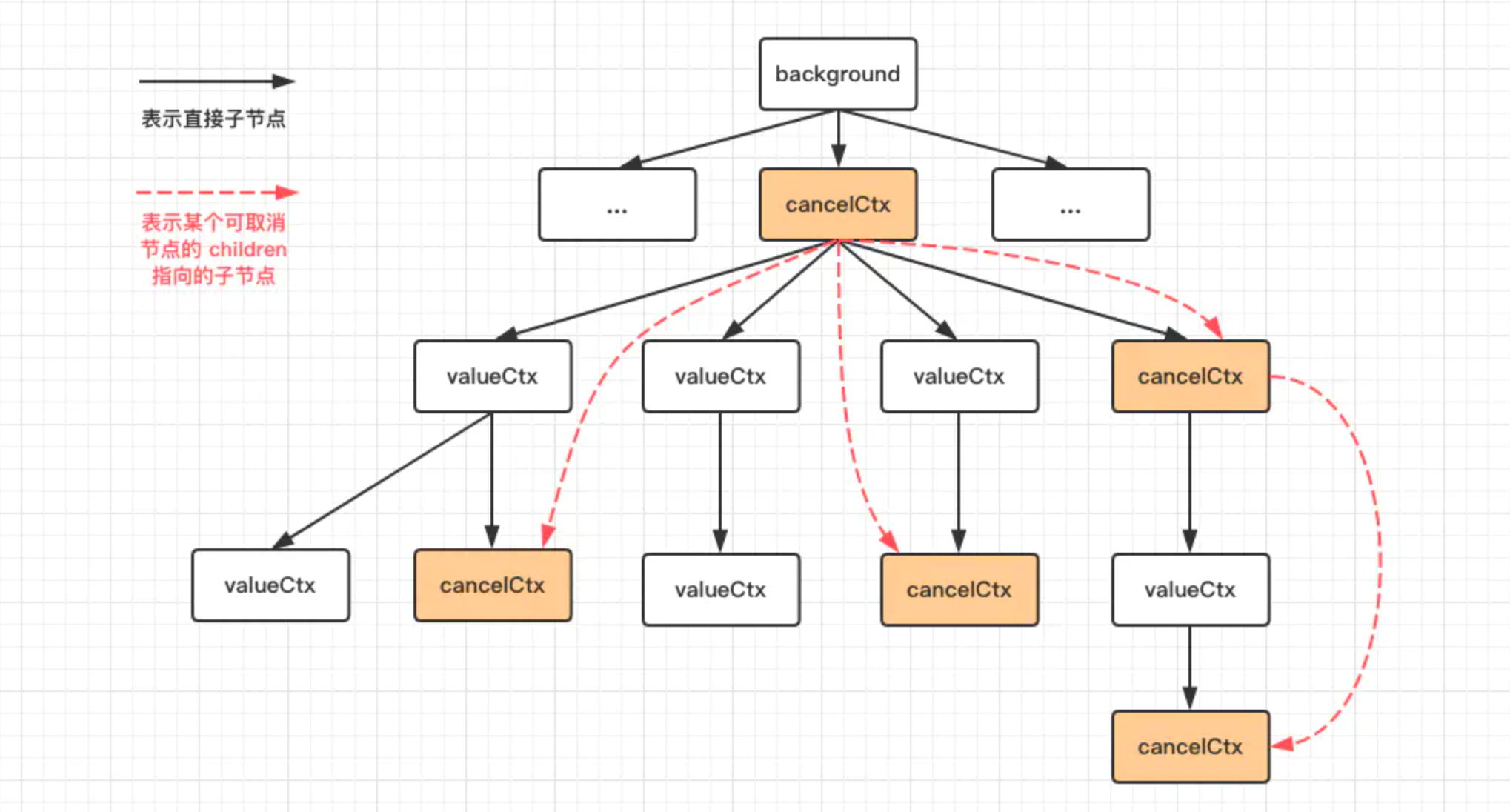
官方Demo
1 | package main |
调用Context Done方法取消
Deadline,Done,Err,Value四个方法中常用的就是Done了,如果Context取消的时候,我们就可以得到一个关闭的chan,关闭的chan是可以读取的,所以只要可以读取的时候,就意味着收到Context取消的信号了,以下是这个方法的经典用法。
1 | func Stream(ctx context.Context, out chan<- Value) error { |
通过 context.WithValue 来传值
1 | func main() { |
超时取消 context.WithTimeout
1 | package main |
截止时间 取消 context.WithDeadline
1 | package main |
手动取消context.WithCancel
1 | func main() { |
Context控制多个goroutine
1 | func main() { |